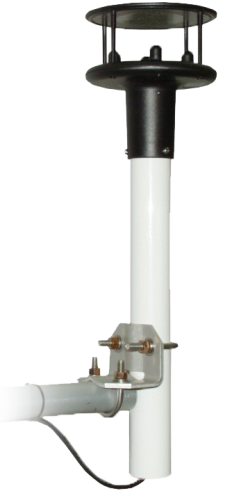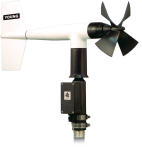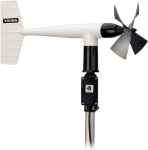
Minimizes routine maintenance costs






Overview
The WindSonic4 is a two-dimensional ultrasonic anemometer for measuring wind direction and speed. It provides an alternative to traditional mechanical cup and vane or propeller and vane anemometers. This sonic wind sensor outputs an SDI-12 signal that can be read a a compatible Campbell Scientific data logger. (See the Compatibility section.)
The WindSonic4 is not recommended for conditions where rime, ice, or horizontal snow will occur. This sensor is not heated. Please contact Campbell Scientific for information on a heated 2-D sonic anemometer that will work in these conditions.
Note: The mounting equipment supplied with this sensor may vary depending on which Campbell Scientific regional office the sensor is ordered from.
Read MoreBenefits and Features
- Low maintenance—no moving parts significantly reduces maintenance cost and time
- Provides a minimum detectable wind speed of 0.01 meters per second
- Compatible with most Campbell Scientific data loggers
Images



Similar Products
Detailed Description
The WindSonic4 uses two pairs of orthogonally oriented transducers to sense the horizontal wind. The transducers bounce the ultrasonic signal from a hood, thus minimizing the effects of transducer shadowing and flow distortion.
Unlike mechanical anemometers, the WindSonic4 has no moving parts to be periodically replaced—minimizing routine maintenance costs.
Compatibility
Mounting
The WindSonic4 is shipped with the 17387 mounting kit. This mounting kit is used to attach the sensor to a CM202, CM204, or CM206 crossarm. The crossarm is then mounted to a tripod or tower.
Data Logger Considerations
The WindSonic4 is connected to one control port, +12 Vdc, and ground. Up to ten WindSonic4s (each with a unique address) can be connected to one data logger control port.
Programming
The SDI12 instruction is used to collect data from the WindSonic4.
Specifications
| Applications |
|
| Sensor | 2-dimensional ultrasonic anemometer |
| Measurement Description | Wind speed and direction |
| Operating Humidity Range | < 5% to 100% RH |
| Operating Temperature Range | -35° to +70°C |
| Storage Temperature Range | -40° to +80°C (typical) |
| Input Voltage | 9 to 30 Vdc |
| Typical Current Drain | < 10 mA (@12 V) |
| Measurement Frequency | 40 Hz block averaged to a 1 Hz output frequency |
| Outputs Parameters | Polar (direction and speed) or orthogonal (Ux and Uy wind) |
| Output Signal | SDI-12 version 1.3 |
| Diameter | 14.2 cm (5.6 in.) |
| Length | 16.0 cm (6.3 in.) |
| Weight | 0.5 kg (1.1 lb) |
Maximum Cable Length |
|
| -NOTE- | For longer cable lengths, contact Campbell Scientific. |
| 1 Sensor Connected to 1 Port | 91.44 m (300 ft) |
| 2 to 10 Sensors Connected to 1 Port | 60.91 m (200 ft) |
Wind Direction |
|
| Range | 0º to 359° (no dead band) |
| Accuracy | ±3° |
| Resolution | 1° |
Wind Speed |
|
| Range | 0 to 60 m/s |
| Accuracy | ±2% (@ 12 m/s) |
| Resolution | 0.01 m/s |
Documents
Product Brochures
Frequently Asked Questions
Number of FAQs related to WINDSONIC4-L: 6
Expand AllCollapse All
-
There are no user-serviceable parts on the WindSonic1 and WindSonic4. Should the WindSonic require service, it will start setting diagnostic flags. Campbell Scientific recommends that all data logger programs record the total number of times the flags are set in an output period. For details, see the WindSonic Instruction Manual.
-
The fastest output frequency is 4 Hz for the WindSonic1 and 1 Hz for the WindSonic4.
-
Yes, as long as these two conditions are met:
- There are no obstructions in the measurement volume.
- The temperature is between -35 to +70 degrees Celsius.
-
All WindSonics (option 1 or option 4) are shipped from Campbell Scientific with an interface cable. If the cable has been lost, order a replacement. Order model WINDSONIC1CBL-Lxx for an option 1 or WINDSONIC4CBL-Lxx for an option 4, where xx is the cable length. The maximum cable length is 50 feet for option 1. The maximum cable on the SDI-1 bus is 200 feet.
-
The WindSonic is not suitable for measuring the vertical wind component. The WindSonic measures the wind that passes through its measurement volume. It does not care what the orientation is. If the WindSonic is turned on its side, the reflecting top and body of the sensor will cause massive flow distortion of the wind vector, specifically for the horizontal component that is perpendicular to the reflective top. This flow distortion will most likely result in erroneous vertical wind measurements.
-
The fundamental measurement frequency of the WindSonic is 40 Hz (40 measurements per second). These measurements are then averaged to give an output at some slower output frequency. For a WindSonic programmed to produce 1 Hz data, all 40 measurements are averaged. (This is called a block average.) For a WindSonic that is programmed to produce 4 Hz data, each output is the block average of 10 fundamental measurements.
Casos de estudio
Tropical volcanic islands are biodiversity hotspots where the Critical Zone (CZ) remains poorly studied. In......read more











